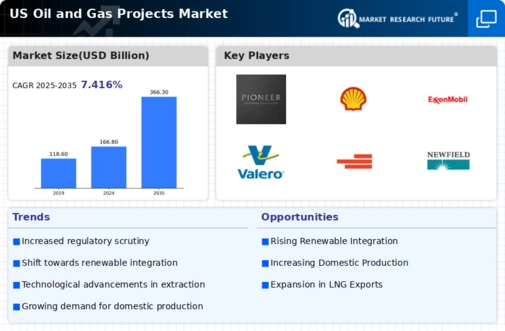The competitive landscape of the US Oil and Gas Projects Market is characterized by a dynamic array of players, each vying for market share amidst fluctuating global oil prices, regulatory changes, and evolving consumer demands for energy. This market is influenced by multiple factors including technological advancements, capital investments, and sustainability initiatives. Companies in this sector are continuously adapting their operational strategies to optimize resource extraction and production efficiency. Competition is not only marked by traditional energy companies but also by emerging players who specialize in renewable energy technologies.
This ongoing competition drives innovation and can significantly impact project timelines, costs, and overall profitability within the market.
Pioneer Natural Resources has established itself as a formidable competitor in the US Oil and Gas Projects Market through its strategic focus on the Permian Basin, a region known for its prolific oil reserves. The company capitalizes on advanced drilling techniques and a robust operational framework that enhances its productivity and efficiency in resource extraction. Pioneer's strength lies in its effective management of assets and its ability to navigate the complex regulatory environment. The firm maintains a strong financial position, enabling it to invest in technology and research that further solidify its market presence.
Additionally, the company emphasizes sustainability within its operations, aligning with the growing demand for responsible energy production, thereby bolstering its reputation and competitive edge in the US market.
Shell has made significant inroads in the US Oil and Gas Projects Market, offering a diverse portfolio of products and services that cater to both traditional and renewable energy needs. The company is recognized for its comprehensive approach to energy solutions, which includes exploration, production, and refining. Shell’s strength is further evidenced by its considerable investments in innovative technologies that enhance oil recovery and reduce environmental impact. The company actively engages in strategic mergers and acquisitions that allow it to expand its operational footprint and access new markets.
In the US, Shell leverages its extensive infrastructure and logistical capabilities to optimize supply chain efficiency. The focus on sustainability is also a key driver for Shell, aligning with current trends towards greener energy that resonate with both regulators and consumers. Through these initiatives, Shell maintains a robust presence in the competitive landscape while addressing evolving energy demands.





















Leave a Comment